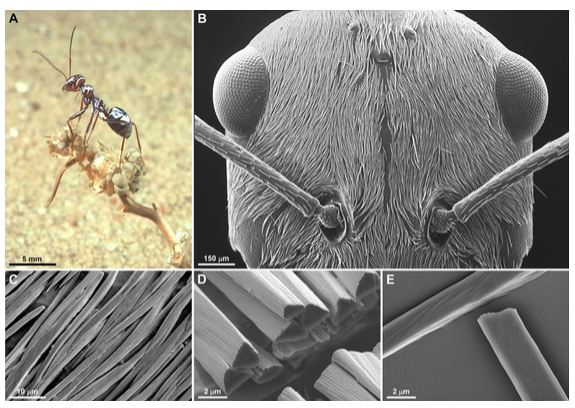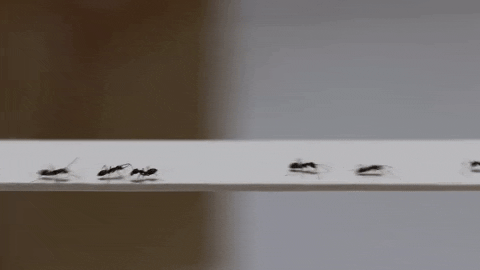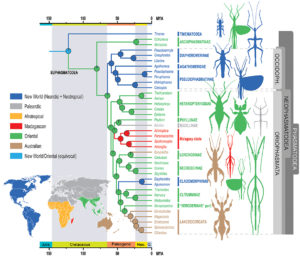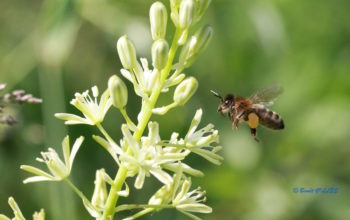Desert ants of the species Cataglyphis bombycina live in environments with extreme temperature conditions. In the middle of the day, despite an outside temperature sometimes close to 70°C on the surface of the ground, they manage to maintain their body temperature below the deadly 53.6°C. An American team, led by Normann Nan Shi, has just unravelled the mystery of this feat and the role of silver-coloured hairs on the surface of their bodies. The unique configuration of these triangular-shaped hairs gives these ants the ability to reflect almost all the light waves of both the visible and infrared spectrum: a double thermoregulation phenomenon allowing particularly efficient heat dissipation on the insect’s surface.
Desert ants
Also called “silver ants” because of their metallic reflections, the Cataglyphis bombycina occur in the Sahara desert, one of the warmest and most hostile regions of the planet ( see illustration 1). To avoid nocturnal predators (reptiles for example), individuals leave during the day in search of food: insect corpses killed by heat sometimes exceeding 70°C on the ground at noon (see videos at the end of the page).
caption id=”attachment_2191″ align=”alignright” width=”350″] Illustration 1 : A) Individual Cataglyphis bombycina, B) Head covered with silver hairs, C) Silver hairs tapering at the tip, D) Triangular cross section of hairs, E) Flat bottom face of the hairs (Source : Shi et al.2015)[/caption]
Illustration 1 : A) Individual Cataglyphis bombycina, B) Head covered with silver hairs, C) Silver hairs tapering at the tip, D) Triangular cross section of hairs, E) Flat bottom face of the hairs (Source : Shi et al.2015)[/caption]
This species has acquired, during evolution, physiological and anatomical adaptations allowing it to survive with body temperatures close to 50°C (lethal temperature : 53.6°C) and thus occupy an ecological niche without competition.
During their travels, these ants take breaks to evacuate excess heat, a behavior called cooling-off. During the hottest hours, these stops can represent nearly 70% of travel time.
Using optical and thermodynamic measurements, Shi and his colleagues modelled heat transfers at the surface of ants’ bodies. The idea is to understand how a triangular network of hair allows them to maintain lower temperatures than their environment (poikilotherme: having a body temperature dependent on that of the environment, also called “cold-blooded” species). Scientists have demonstrated the intervention of two physical phenomena:
- Hair reflects much of the sun’s visible spectrum and infrared radiation
- Hair promotes heat radiation in the environment by improving emissivity (amount of thermal energy emitted by an object)
Hair as reflectors
Observing the surface of an ant using a scanning electron microscope (SEM), this team discovered that the hairs were densely and uniformly arranged, aligned in the same direction and tapering at their tips. The most remarkable structural configuration of these triangular hairs is that they have two wavy faces, the third being flat bottom (cuticle side) (see illustration 1).
In sunlight, the hairy areas of the ant reflect 67% of the radiation against only 41% when the hairs have been removed (see illustration 2). The gain lies in the triangular configuration of the hairs which improves the diffusion of wavelengths to better reflect them in the environment afterwards.
caption id=”attachment_2193″ align=”aligncenter” width=”514″] Illustration 2 : Results of thermodynamic experiments, B) and C) Body temperature profile at the surface of the head with or without hair, in vacuum and in air – E) and F) Body temperature profile at the surface of the gastrium (abdomen) with or without hair, in vacuum and in air (Source : Shi et al., 2015)[/caption]
Illustration 2 : Results of thermodynamic experiments, B) and C) Body temperature profile at the surface of the head with or without hair, in vacuum and in air – E) and F) Body temperature profile at the surface of the gastrium (abdomen) with or without hair, in vacuum and in air (Source : Shi et al., 2015)[/caption]
The lower part of the body of ants is hairless in order to reflect more effectively the infra-red coming from the ground: they thus improve emissivity.
This discovery brings valuable information to important technological spin-offs (biomimetic coatings for passive object cooling, for example).
Source :
– Shi et al (2015) : Keeping cool : Enhanced optical reflection and heat dissipation in silver ants – Science Express (lien)





